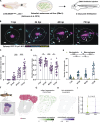Real-time imaging reveals a role for macrophage protrusive motility in melanoma invasion
- PMID: 39570286
- PMCID: PMC11586626
- DOI: 10.1083/jcb.202403096
Real-time imaging reveals a role for macrophage protrusive motility in melanoma invasion
Abstract
Macrophages are primary cells of the innate immune system that mediate tumor progression. However, the motile behavior of macrophages and interactions with tumor cells are not well understood. Here, we exploit the optical transparency of larval zebrafish and perform real-time imaging of macrophage-melanoma interactions. We found that macrophages are highly motile in the tumor microenvironment. Macrophages extend dynamic projections between tumor cells that precede invasive melanoma migration. Modulating macrophage motility with a dominant inhibitory mutation in Rac2 inhibits recruitment to the tumor and impairs tumor invasion. However, a hyperactivating mutation in Rac2 does not affect macrophage recruitment but limits macrophage projections into the melanoma mass and reduces invasive melanoma cell migration. Taken together, these findings reveal a role for Rac2-mediated macrophage protrusive motility in melanoma invasion.
© 2024 Ramakrishnan et al.
Conflict of interest statement
Disclosures: All authors have completed and submitted the ICMJE Form for Disclosure of Potential Conflicts of Interest. R.M. White reported personal fees from Qiagen outside the submitted work. No other disclosures were reported.
Figures







References
-
- Bojarczuk, A., Miller K.A., Hotham R., Lewis A., Ogryzko N.V., Kamuyango A.A., Frost H., Gibson R.H., Stillman E., May R.C., et al. . 2016. Cryptococcus neoformans intracellular proliferation and capsule size determines early macrophage control of infection. Sci. Rep. 6:21489. 10.1038/srep21489 - DOI - PMC - PubMed
-
- Campbell, N.R., Rao A., Hunter M.V., Sznurkowska M.K., Briker L., Zhang M., Baron M., Heilmann S., Deforet M., Kenny C., et al. . 2021. Cooperation between melanoma cell states promotes metastasis through heterotypic cluster formation. Dev. Cell. 56:2808–2825.e10. 10.1016/j.devcel.2021.08.018 - DOI - PMC - PubMed
MeSH terms
Substances
Grants and funding
LinkOut - more resources
Full Text Sources
Medical
Molecular Biology Databases

